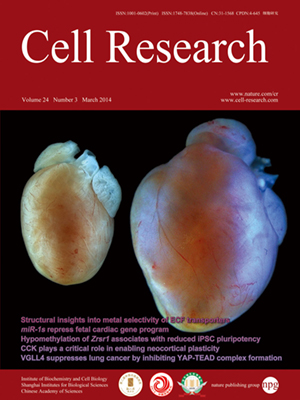
Volume 24, No 3, Mar 2014
ISSN: 1001-0602
EISSN: 1748-7838 2018
impact factor 17.848*
(Clarivate Analytics, 2019)
Volume 24 Issue 3, March 2014: 267-277 | Open Access
ORIGINAL ARTICLES
Planar substrate-binding site dictates the specificity of ECF-type nickel/cobalt transporters
You Yu1,2, Mingze Zhou1,2, Franziska Kirsch3, Congqiao Xu4, Li Zhang1,2, Yu Wang5, Zheng Jiang5, Na Wang1,2, Jun Li4, Thomas Eitinger3 and Maojun Yang1,2
1MOE Key Laboratory of Protein Sciences, Tsinghua-Peking Center for Life Sciences, School of Life Sciences, Tsinghua University, Beijing 100084, China
2Department of Pharmacology and Pharmaceutical Sciences, School of Medicine, Tsinghua University, Beijing 100084, China
3Humboldt-Universität zu Berlin, Institut für Biologie/Mikrobiologie, 10115 Berlin, Germany
4Department of Chemistry, Tsinghua University, Beijing 100084, China
5Shanghai Synchrotron Radiation Facilities, Shanghai Institute of Applied Physics, Chinese Academy of Sciences, Shanghai 201204, China
Correspondence: Maojun Yang, E-mail: maojunyang@tsinghua.edu.cn Tel: +86-10-6278-9400; Fax: +86-10-6279-2736; Thomas Eitinger, E-mail: thomas.eitinger@cms.hu-berlin.de Tel: +49-30-2093-8103; Fax: +49-30-2093-8102; Jun Li, Tel: +86-10-6279-5381; Fax: +(junli@tsinghua.edu.cn)
The energy-coupling factor (ECF) transporters are multi-subunit protein complexes that mediate uptake of transition-metal ions and vitamins in about 50% of the prokaryotes, including bacteria and archaea. Biological and structural studies have been focused on ECF transporters for vitamins, but the molecular mechanism by which ECF systems transport metal ions from the environment remains unknown. Here we report the first crystal structure of a NikM, TtNikM2, the substrate-binding component (S component) of an ECF-type nickel transporter from Thermoanaerobacter tengcongensis. In contrast to the structures of the vitamin-specific S proteins with six transmembrane segments (TSs), TtNikM2 possesses an additional TS at its N-terminal region, resulting in an extracellular N-terminus. The highly conserved N-terminal loop inserts into the center of TtNikM2 and occludes a region corresponding to the substrate-binding sites of the vitamin-specific S components. Nickel binds to NikM via its coordination to four nitrogen atoms, which are derived from Met1, His2 and His67 residues. These nitrogen atoms form an approximately square-planar geometry, similar to that of the metal ion-binding sites in the amino-terminal Cu2+- and Ni2+-binding (ATCUN) motif. Replacements of residues in NikM contributing to nickel coordination compromised the Ni-transport activity. Furthermore, systematic quantum chemical investigation indicated that this geometry enables NikM to also selectively recognize Co2+. Indeed, the structure of TtNikM2 containing a bound Co2+ ion has almost no conformational change compared to the structure that contains a nickel ion. Together, our data reveal an evolutionarily conserved mechanism underlying the metal selectivity of EcfS proteins, and provide insights into the ion-translocation process mediated by ECF transporters.
10.1038/cr.2013.172
FULL TEXT | PDF
Browse 2460


